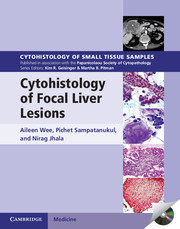Book contents
- Frontmatter
- Dedication
- Contents
- CONTRIBUTING AUTHOR
- Preface
- 1 The focal liver lesion: general considerations
- 2 Morphologic approach
- 3 Diagnostic algorithm
- 4 Focal liver lesions with low or no suspicion of malignancy
- 5 Focal liver lesions suspicious of hepatocellular carcinoma
- 6 Focal liver lesions suspicious of intrahepatic cholangiocarcinoma
- 7 Focal liver lesions from metastases and other malignancies
- 8 Focal liver lesions with cystic appearance
- 9 Focal liver lesions in infants and children
- 10 Ancillary studies
- 11 Techniques and technology in practice
- Index
4 - Focal liver lesions with low or no suspicion of malignancy
Published online by Cambridge University Press: 05 April 2015
- Frontmatter
- Dedication
- Contents
- CONTRIBUTING AUTHOR
- Preface
- 1 The focal liver lesion: general considerations
- 2 Morphologic approach
- 3 Diagnostic algorithm
- 4 Focal liver lesions with low or no suspicion of malignancy
- 5 Focal liver lesions suspicious of hepatocellular carcinoma
- 6 Focal liver lesions suspicious of intrahepatic cholangiocarcinoma
- 7 Focal liver lesions from metastases and other malignancies
- 8 Focal liver lesions with cystic appearance
- 9 Focal liver lesions in infants and children
- 10 Ancillary studies
- 11 Techniques and technology in practice
- Index
Summary
INTRODUCTION
Focal liver lesions that are assigned this clinical setting of low or no suspicion of malignancy are likely to be “incidentalomas” discovered in asymptomatic patients during health screening, or in symptomatic patients undergoing investigations for nonhepatic-related conditions. Most of them are small and will eventually turn out to be benign. Not all focal liver lesions discovered during staging or follow-up surveillance of cancer patients are due to metastases either. Regular ultrasound surveillance of patients with hepatitis B and C cirrhosis has led to an increasing number of small hepatocellular nodular lesions being detected.
Benign focal lesions are frequently detected during imaging of the liver. Most benign tumors can be characterized on ultrasound, computerized tomography (CT), and magnetic resonance imaging (MRI) with corroborative clinical information and demonstration of typical imaging characteristics and normal background parenchyma, such as hemangioma and focal nodular hyperplasia (FNH). Differentiating benign from malignant entities may be difficult when they show atypical or overlapping imaging features. Hepatocellular adenomas (HCAs), owing to their variable appearances, often present diagnostic difficulties and are the most common benign tumor to undergo biopsy confirmation. Rare tumors, such as angiomyolipoma, often simulate metastases and other primary hepatic lesions on imaging. Some hepatocellular nodules that are associated with cirrhosis may carry a higher index of suspicion and are, hence, aspirated or biopsied.
When clinical and radiologic features concur, the role of biopsy is twofold: (i) for definitive characterization of the benign lesion, and (ii) to refute the remote possibility of malignancy. For practical purposes, solid focal liver lesions in this clinical setting are addressed under pattern/ cell profile, namely, hepatocellular, glandular/biliary, mesenchymal, and hematopoietic/inflammatory patterns. The diagnostic algorithm is given in Table 4.1. Benign cystic lesions are discussed in Chapter 8.
TUMORS AND TUMOR-LIKE LESIONS WITH HEPATOCELLULAR PATTERN
In association with normal liver
Focal fatty change
CLINICAL FEATURES
The liver shows single or multiple, geographic, or nodular areas of fatty change.
- Type
- Chapter
- Information
- Cytohistology of Focal Liver Lesions , pp. 66 - 99Publisher: Cambridge University PressPrint publication year: 2000

